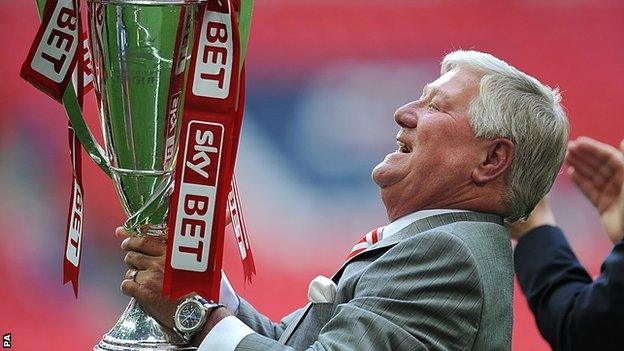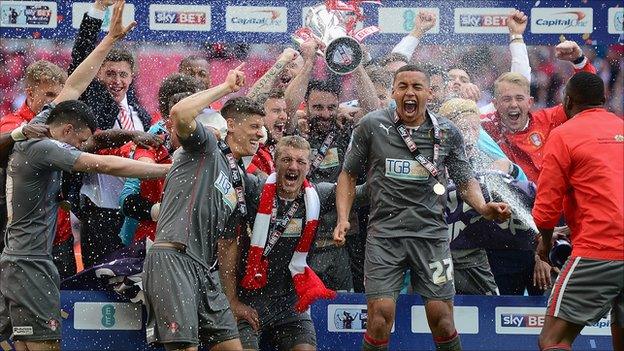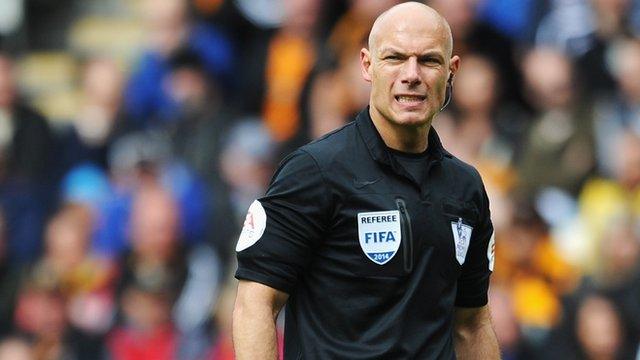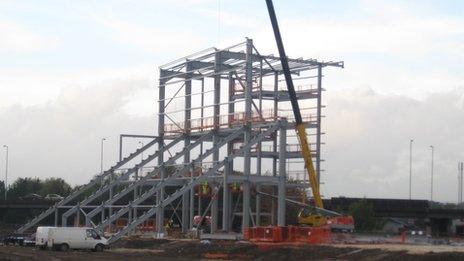Tony Stewart: The man behind Rotherham United's rise
- Published

'Start spreading the news, I'm leaving today, I want to be a part of it, New York, New York.'
Those words sung by Frank Sinatra for Martin Scorsese's classic 1970s film, external were ones Rotherham chairman Tony Stewart might have hoped to hear in the town's streets in July 2012 as they moved in to the New York Stadium, its name taken from that of the local area.
After four years playing home games outside Rotherham, it marked a return 'home' for the Millers. But little could Stewart have realised it would result in such an upturn in fortunes on the pitch too.
"I took over the club six years ago and decided to build a ground that was fit for the purpose, then start working with managers to get confidence back into the town," said the owner of Rotherham-based ASD Lighting PLC after the Millers secured Championship promotion by beating Leyton Orient on penalties in the League One play-off final.
And as chants of 'there's only one Tony Stewart' rang out inside English football's national stadium, neutrals could be forgiven for wondering who the United fans were singing about.
Millers chairman targets Premier League
In a town perhaps more famous for providing the sport with World Cup final referee Howard Webb, than South Yorkshire's second Championship football team, he is the man that saved their club.
"If you're not a Rotherham fan, you can't understand the ups and downs we've had these past few years," one supporter told the Football League Show on the steps of Wembley.
We can at least try to.
'These vagabond shoes, they are longing to stray'... a little strong? It is closer to the mark than you would think.
In 2008, Stewart bought a club in administration,, external preparing for a season in the Football League's basement division with a 17-point penalty.
That was only the half of it. A factor in the Millers' dire financial situation was the rent being charged at their stadium, Millmoor.
The landlords failed to strike a deal with Stewart, and with heavy heart, he laced those vagabond shoes and strayed across the M1 to nearby Sheffield., external
Rotherham bedded down at the now-demolished Don Valley Stadium, with Stewart promising to fund construction of a new home in the S60 post-code range.
A facility built for the hosting of athletics at the 1991 World University Games, Rotherham were welcome tenants for Sheffield City Council, which was struggling to cover the stadium's bills via the rent of Championship rugby league side Sheffield Eagles and the occasional athletics meeting.
This lighting salesman from Rotherham could not have fathomed that six years later United would be two divisions higher. Could he?
"My dream is probably to get to the top of the Championship. Talk to Hull, talk to Barnsley, these teams have done it before," Stewart told BBC Radio Sheffield two years ago.
Three months later they made a brand new start of it.
The £17m New York Stadium was to be Rotherham's new home, a name coined from the fact the area previously housed the site of old steelworks firm Guest and Chrimes, a company famed for manufacturing the Big Apple's iconic red fire hydrants.
After four years of League Two - including a play-off final defeat by Dagenham & Redbridge, external - and four managers, Stewart had made good on his pledge as the Millers returned to S60, a stone's throw from Millmoor.
As their final season in exile was drawing to a close, then Crawley Town manager Steve Evans was recruited as boss. His arrival, along with the stadium move, sparked Rotherham's remarkable rise.
The Glaswegian overhauled a squad Andy Scott had struggled to get the best out of, bringing in 12 and moving out seven players over that summer.
And the 51-year-old's first full season started as Stewart had no doubt dreamed.
A 3-0 win over Burton in the new, New York Stadium was witnessed by 11,441 people - a far cry from the 4,484 that attended the curtain-raiser at Don Valley four years earlier.
In April, victory over Aldershot Town, ironically under the tutelage of his predecessor, secured Evans' seventh promotion as a manager.
"I walked out on Crawley 12 months ago to come to a club that I believe could be a Championship club," Evans proclaimed after finishing, not quite top of the heap, as League Two runners-up.
"We've got a lot of hard work to do to just be a League One club, but we'll get there very quickly under a fantastic chairman and supporters that have been incredible all season."
More evolution than revolution came in Evans' second close-season as he tweaked his squad for their first third-tier campaign since 2006-07.
And as Stewart had hoped, people did want to 'be a part of it' in New York.
His town's enthusiasm for football did not wane. An average home gate of 8,580 saw United spend the final six months of the campaign in the play-off places, ultimately securing promotion by overcoming Preston North End and then Leyton Orient.
"The fans have been absolutely magnificent. I know how much it hurt them against Dagenham four years ago," Evans told BBC Radio Sheffield.
"How could you ever forget what we've achieved in these last two years? If you offered me a lottery win or this, it would be this.
"I've been working for a great chairman but they're not always good days. There are days where there's a debate, days that aren't easy ones, but that's why Tony Stewart is as successful as he is.
"He's a man who has everything, so for him to tell me I've given him something money couldn't buy, I'm extremely proud."
His chairman is not done yet.
"For me, taking over was a challenge and it's a challenge I've enjoyed," said Stewart.
"I always say, whatever league you're in, you're in it to win it, to be at the pinnacle of that league.
"There's only one step higher than the Championship - the adventure goes on."
And £30m,, external six years, four managers and two promotions down the road, Stewart still wants to be top of the list, head of the heap, king of the hill.
Right there in old New York.
Interviews by BBC Radio Sheffield's Andy Giddings and Rob Staton, and the Football League Show's Mark Clemmit.
- Published25 May 2014

- Published23 May 2014

- Published27 April 2013

- Published18 August 2012

- Published13 April 2012

- Published9 April 2012

- Attribution
- Published25 October 2011

- Published7 June 2019
